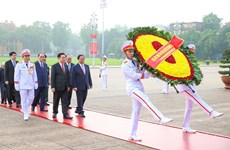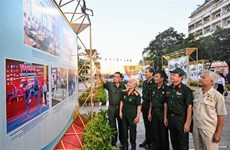Vietnamese, Italian designers promote "ao dai" to the world
 Designer Ngoc Han in a show of ao dai (Photo: VietnamPlus)
Designer Ngoc Han in a show of ao dai (Photo: VietnamPlus) Hanoi (VNA) - The Italian Embassy in Hanoi and the Vietnamese Embassy in Rome, along with their partners, officially launched the "Ao Dai Heritage - Culture of Love" project on September 8.
This is a meaningful activity to strengthen cultural cooperation between Vietnam and Italy ahead of the 50th anniversary of bilateral diplomatic relations (1973-2023).
According to Italian Ambassador to Vietnam Antonio Alessandro, the project aims to promote cultural exchanges between Vietnam and Italy through the cooperation of the two countries' designers to promote the "ao dai" heritage in the international fashion market while applying the quintessence of Italian technology to the making of the Vietnamese traditional long dress.
Ambassador Alessandro affirmed that new values would be formed based on national values and the era's strength.
'Ao dai' catches the attention of foreigners, according to Huy Thanh, a member of Golden Heritage Group.
"Ao dai' can tell the world a lot about Vietnam," said Thanh.
Under the project, Vietnamese and Italian designers will create a collection of 60 "ao dai". There will be two "ao dai" shows each year over five years to be held in cities with famous cultural values and heritages worldwide.
At an earlier press conference, a collection of "ao dai" by Italian designer Maria Elena Di Terlizzi and her Vietnamese peer Quang Hoa, who comes from Hue city in central Vietnam, dubbed as the capital of the "ao dai", was introduced.
The Italian designer showed great confidence in the potential of the 'ao dai' renovation project in the European market, where female customers love to try new experiences.
Currently, she has established a network of customers interested in Vietnamese garments.
"I'm here to learn Vietnamese traditions and bring European modernity into the Vietnamese 'ao dai,' making it a popular clothing choice for everyone," said Elena.
She plans to adjust the "ao dai" form and use new Italian materials to add comfort and give the traditional outfit a more youthful, modern, and convenient appeal.
"A very feminine and elegant outfit requires the wearer to follow implicit rules and certain cultural norms," Elena said.
"Ao dai", the traditional costume of Vietnam that is familiar among international friends, has a long history of development. As a result, it is diverse in designs and materials that vary in different regions.
The story of the "ao dai" started in 1744, when Vietnam was divided into two parts, the Inner Land (Dang Trong) and Outer Land (Dang Ngoai.) To distinguish his people, Lord Nguyen Phuc Khoat of the Inner Land asked his people to wear a front-buttoned gown with trousers. This five-part dress (ao ngu than) inspired the modern "ao dai". Royals and elites made dresses from the finest silk, with intricate details and vibrant colours to represent rankings in court.
In the 1930s, the dress was simplified into two parts by Vietnamese artist Le Mur Nguyen Cat Tuong. First, the front flap was extended to reach the ankle, and the form became more fitted.
After the establishment of the Democratic Republic of Vietnam, President Ho Chi Minh penned an essay in 1947 asking Vietnamese to adapt their attire to be more efficient for work. As a result, it became a dress saved for professional appearances and special occasions. Nowadays, female high school students must wear clothing for at least one day a week across the country. Girls in white "ao dai" riding their bicycles to school have inspired many Vietnamese songs, poems, and paintings.
Vietnamese women love wearing "ao dai" for photo shoots in beautiful settings. Golden Autumn days in Hanoi call for photo sessions around Hoan Kiem Lake. During Tet (Lunar New Year) holiday, women wear it to visit friends and relatives and pay tribute at temples and shrines. A wedding is a perfect occasion to wear one's best "ao dai". The bride and groom and the wedding entourage wear elaborate "ao dai" at the traditional ceremony. Then guests show up for the reception in simpler but equally colourful designs./.












